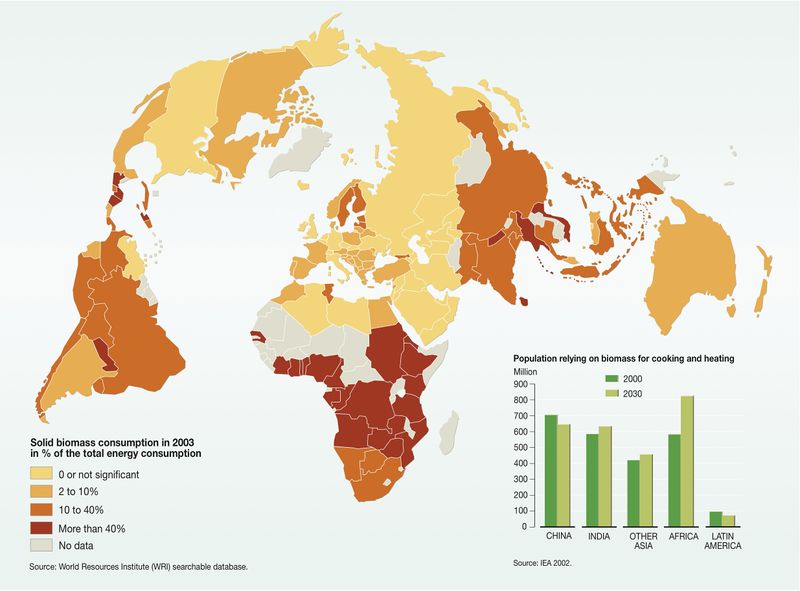Knowledge fuels change - Support energypedia!
For over 10 years, energypedia has been connecting energy experts around the world — helping them share knowledge, learn from each other, and accelerate the global energy transition.
Today, we ask for your support to keep this platform free and accessible to all.
Even a small contribution makes a big difference! If just 10–20% of our 60,000+ monthly visitors donated the equivalent of a cup of coffee — €5 — Energypedia would be fully funded for a whole year.
Is the knowledge you’ve gained through Energypedia this year worth €5 or more?
Your donation keeps the platform running, helps us create new knowledge products, and contributes directly to achieving SDG 7.
Thank you for your support, your donation, big or small, truly matters!
Basics on Biomass
Overview
There are a wide variety of biomass energy resources, including tree and grass crops and forestry, agricultural, and urban wastes. Biomass is the oldest source of renewable energy known to humans. It is a renewable energy source because the energy it contains comes from the sun. Through the process of photosynthesis, chlorophyll in plants captures the sun's energy by converting carbon dioxide from the air and water from the ground into carbohydrates, complex compounds composed of carbon, hydrogen, and oxygen. When these carbohydrates are burned, they turn back into carbon dioxide and water and release the sun's energy they contain.
There are many types of plants and many ways in which they can be used for energy production. In general there are two approaches: Energy crops - growing plants specifically for energy use, and biomass residues - using the residues from plants that are used for other things. The best approaches vary from region to region according to climate, soils, geography and population.
Wood is still the largest biomass energy resource today, but other sources of biomass can also be used. These include food crops, grassy and woody plants, residues from agriculture or forestry, and the organic component of municipal and industrial wastes. Even the fumes from landfills (which are methane, a natural gas) can be used as a biomass energy source[1].
Applications and Efficiency
Direct biomass applications:
Includes direct combustion or co-firing with fossil fuels.
Indirect biomass application:
A number of non-combustion methods are available for converting biomass to energy. These processes convert raw biomass into a variety of gaseous, liquid, or solid fuels that can then be used directly for energy generation. The carbohydrates in biomass, which are comprised of oxygen, carbon, and hydrogen, can be broken down into a variety of chemicals, some of which are useful fuels.
This conversion can be done in three ways:
- Thermo-chemical
- Bio-chemical
- Chemical
Thermo-chemical
When plant matter is heated but not burned, it breaks down into various gases, liquids, and solids. These products can then be further processed and refined into useful fuels such as methane and alcohol. Biomass gasifiers capture methane released from the plants and burn it in a gas turbine to produce electricity. Another approach is to take these fuels and run them through fuel cells, converting the hydrogen-rich fuels into electricity and water, with few or no emissions.
Bio-chemical
Bacteria, yeasts, and enzymes also break down carbohydrates. Fermentation changes biomass liquids into alcohol, a combustible fuel. A similar process is used to turn corn into grain alcohol or ethanol, which is mixed with gasoline to make gasohol. Also, when bacteria break down biomass, methane and carbon dioxide are produced. This methane can be captured, in sewage treatment plants and landfills, for example, and burned for heat and power.
Chemical
Biomass oils, like soybean and canola oil, can be chemically converted into a liquid fuel similar to diesel fuel, and into gasoline additives. Cooking oil from restaurants, for example, has been used as a source to make "bio diesel" for trucks. Bio diesel can also be produced using algae as a source of oils. Biodiesel is made by combining alcohol (usually methanol) with vegetable oil, animal fat, or recycled cooking grease. It can be used as an additive (typically 20%) to reduce vehicle emissions or in its pure form as a renewable alternative fuel for diesel engines[1].
Capability and Limitations
Biomass can be used for fuels, power production, and products that would otherwise be made from fossil fuels.
In such scenarios, biomass can provide an array of benefits which include:
- Potential to greatly reduce greenhouse gas emissions. Burning biomass releases about the same amount of carbon dioxide as burning fossil fuels. Fossil fuels release carbon dioxide captured by photosynthesis millions of years ago. Biomass, on the other hand, releases carbon dioxide that is largely balanced by the carbon dioxide captured in its own growth (depending how much energy was used to grow, harvest, and process the fuel). Replacing the biomass harvested results in a sustainable cycle of carbon dioxide emission and sequestration.
- The use of biomass can reduce dependence on foreign oil because biofuels are the only renewable liquid transportation fuels available[1].
Further Information
- All biomass related articles on energypedia
- Bioenergy Portal on energypedia
- Biomasscenter.org
- Oregon.gov - bioenergy
- Wikipedia.org - Biomass
- Practicalaction.org - biomass as a solid fuel




















